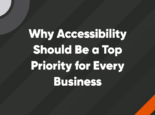
Understanding Web Content Accessibility Guidelines: The Impact on Your Site’s Accessibility

This blog post was originally published in 2018 and has been updated to reflect current information and updates to WCAG.
Having an accessible website is essential if you want to reach all of your potential customers. The continual release of updated international accessibility guidelines creates a clear path for how website designers, developers, and digital marketers can provide a great web experience for every user.
Complying with Web Content Accessibility Guidelines (WCAG) is not only important for creating a more equitable internet that everyone has access to, but also means your website and marketing materials could reach an exponentially wider audience, opening up additional opportunities that can help you achieve your business goals.
What is WCAG?
At its core, WCAG (Web Content Accessibility Guidelines) is about:
- Removing barriers
- Fostering inclusion
- Ensuring fair use
WCAG outlines four principles of accessibility that define how to create web content that is accessible to everyone. To meet the guidelines, web content must be:
- Perceivable
- Operable
- Understandable
- Robust
Sites built with these principles ensure everyone has equal access to the same information and functionality. Unfortunately, the vast majority of websites do not conform to WCAG 2.0 even though they've been in place for over a decade.
What if my website doesn't follow WCAG?
Guilty as sin? At best, you could be alienating potential target customers. At worst, web accessibility non-conformance can result in a lawsuit for federal agencies and businesses of similar positioning.
Is WCAG a law?
These guidelines and their legal implications have always been a bit ambiguous. WCAG in itself isn't a law, but it does make up the benchmark for accessibility-related legislation. Lawsuits related to WCAG typically fall under the Americans with Disabilities ACT (ADA) and Section 508 of the Rehabilitation Act that was enacted in 1973. Federal agencies are one of the business types with the highest risk of lawsuits for non-compliance, but all businesses are prone to lawsuits for non-compliance.
WCAG 2.1
In June 2018, the World Wide Web Consortium (W3C) unveiled the latest update to the Web Content Accessibility Guidelines and gave an official recommendation for WCAG 2.1. The new guidelines further improve the accessibility of content across the web and ensure a complete experience for all users regardless of disabilities. WCAG 2.1 was built upon the existing guidelines established by WCAG 2.0.
Perrill tip: It's much easier to comply with the latest WCAG if your site already complies with the previous WCAG version. Thankfully, backward compatibility means that if you're implementing web accessibility standards for the first time, complying with the most recent version means you will automatically satisfy the criteria for past WCAG and be fully up to date with the latest international accessibility standards.
WCAG 2.2 & ADA compliance for websites
While WCAG 2.2 was released in October of 2023, WCAG 2.1 is still considered the golden standard for accessibility compliance. 2.2 will continue to gain recognition as people slowly begin adopting, but for now, it really indicates where the future of accessibility is heading. No jurisdictions are planning on incorporating WCAG 2.2 into web accessibility laws at the moment. Some prominent laws still point to an even earlier version (WCAG 2.0) as their standard for compliance. If those laws apply to you, you need to conform to WCAG 2.0. Otherwise, conforming to WCAG 2.1 Level AA is the way to go.
Dive Deeper: Colorado is the first state to have their own web accessibility legislation. Sites need to be compliant or have a plan for compliance by a July 1, 2024 deadline
Where are we headed? WCAG 2.1 vs 2.2
As we start to slowly transition from WCAG 2.1 to 2.2, it's important to understand the differences between each set of guidelines. The main difference is the total number of success criteria that make up the web accessibility guidelines themselves–and who the criteria are geared toward. 2.2's updates focus on improving accessibility for users with:
- Cognitive or learning disabilities
- Low vision
- Disabilities on mobile devices
Each success criterion also works to improve how all types of users navigate websites. As we learn more about how people use the web and the different circumstances that can create usability issues for individuals, it makes sense that this list of criteria continues to grow.
Dive Deeper: The following details are fairly technical in nature. You can read specifics about each new criterion if you wish to get an in-depth view of the newest updates.
WCAG success criteria
The following details are fairly technical in nature and provide an in-depth view of the success criteria and the latest 2.2 guidelines.
Here is the amount of success criteria for each update:
- WCAG 2.0: 61
- WCAG 2.1: 78
- WCAG 2.2: 87
There are 9 new success criteria included in the 2.2 guidelines. These criteria are geared toward further improving the user experience for a wide array of disabilities and learning challenges, specifically for those with motor disabilities impacting touchscreen device usage. These updates include:
- 2.4.11 Focus Not Obscured (Minimum) (AA)
- 2.4.12 Focus Not Obscured (Enhanced) (AAA)
- 2.4.13 Focus Appearance (AAA)
- 2.5.7 Dragging Movements (AA)
- 2.5.8 Target Size (Minimum) (AA)
- 3.2.6 Consistent Help (A)
- 3.3.7 Redundant Entry (A)
- 3.3.8 Accessible Authentication (Minimum) (AA)
- 3.3.9 Accessible Authentication (Enhanced) (AAA)
When 2.1 was released, there were 17 new criteria implemented with the primary goal of improving accessibility specifically for people with cognitive learning disabilities, low vision, and disabilities using mobile devices.
Implementing WCAG on your website
Having a fully accessible website helps you reach the widest audience possible and fosters total inclusion across the web. Everyone deserves a complete experience online. These guidelines exist to help us make that happen. If you haven’t begun considering website accessibility and how to ensure your site complies with the latest WCAG version, then now is an excellent time to get your site on the path to accessibility.
But how?
Implementing WCAG is typically a complex procedure that requires manual auditing, live user testing, and a team of professional developers to make it happen. Although there are some basic tools out there that can check your website for many of the WCAG components, these tools are unreliable and not intended to guarantee compliance.
These tools can help you establish some basic groundwork for accessibility, but their limitations can leave you open to expensive lawsuits. Even the federal government cautions against relying solely on tools and advises website owners to regularly perform live user audits.
There are other solutions to ensuring your site is fully accessible, though. With new technological advances, there are now AI widgets you can add to your site that will offer options for your site visitors, providing different experiences based on their disabilities. We partner with accessiBe, an automated accessibility solution that easily integrates with your site and fully meets WCAG and ADA compliance. If you're interested in learning more about accessiBe, feel free to reach out.
Web accessibility solutions for your business
Understanding the technical differences between past and updated WCAG success criteria may be making your head spin as a business leader. What does it all really mean and how do you implement it?
While the threat of a potential or impending accessibility-related lawsuit often proves more motivating than the moral implication of digital inclusion, thankfully there are new solutions like accessiBe that make WCAG compliance achievable for large and small businesses alike.
If you're concerned about meeting the latest WCAG or have never dipped your toes into the world of web accessibility, contact the Perrill team to chat. Our full-service in-house agency is well-versed in the world of accessibility, understands the latest automated solutions, and has helped companies across a wide range of industries reach more of their target customers with accessible websites.
Contact us today to see how our team can help you positively contribute to digital access while achieving your business goals and making the most of your marketing budget.

Nate Tower
Nate Tower is the President of Perrill and has over 12 years of marketing and sales experience. During his career in digital marketing, Nate has demonstrated exceptional skills in strategic planning, creative ideation and execution. Nate's academic background includes a B.A. with a double major in English Language and Literature, Secondary Education, and a minor in Creative Writing from Washington University. He further expanded his expertise by completing the MBA Essentials program at Carlson Executive Education, University of Minnesota.
Nate holds multiple certifications from HubSpot and Google including Sales Hub Enterprise Implementation, Google Analytics for Power Users and Google Analytics 4. His unique blend of creative and analytical skills positions him as a leader in both the marketing and creative worlds. This, coupled with his passion for learning and educating, lends him the ability to make the complex accessible and the perplexing clear.
Join Our Newsletter


Why Google Shouldn’t Reveal Its Search Algorithm


8 Signs You Need a Website Redesign


